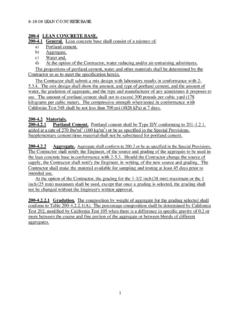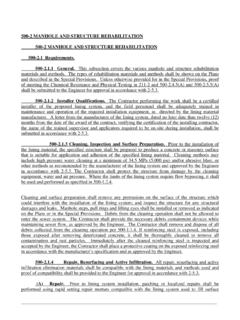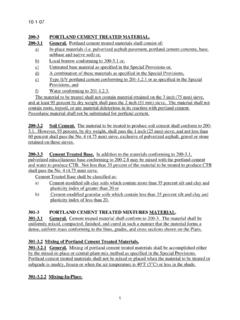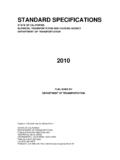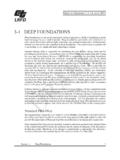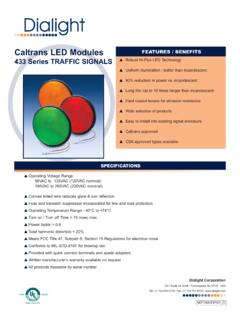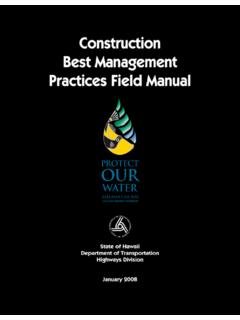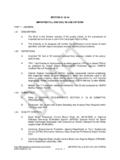Transcription of Style Guide - Public works
1 Style Guide GREENBOOK Committee of Public works Standards, Inc. Editorial Standards Subcommittee July 1, 2010 Version TABLE OF CONTENTS I. PURPOSE .. 4 II. GENERAL CHARACTERISTICS OF SPECIFICATIONS .. 4 Method vs. Performance Specifications .. 4 Specifications Tone .. 5 Characteristics of Well-Written Specifications .. 6 III. ORGANIZATION AND STRUCTURE OF THE GREENBOOK .. 7 Sequence of Specifications .. 8 Sections and Subsections .. 8 Lists .. 9 IV. UPDATING THE GREENBOOK .. 10 Defined Terms .. 10 Acronyms and Abbreviations .. 10 Units of Measurement .. 11 Subsection Nouns .. 11 V. TERMINOLOGY AND PHRASE REFERENCES .. 11 Mandatory Rules, Permissive Rules, and Explanatory Information .. 11 Phrasing.
2 12 Prepositional Phrases .. 13 Modifiers .. 13 Additional Phrases to Avoid .. 13 Sentence 14 Paragraph Cross References .. 14 Avoid Word Pairs .. 15 Avoid Use of Exceptions .. 15 Contextual Ambiguity .. 15 Syntactic Ambiguities .. 16 Ellipsis .. 16 Pronoun References .. 16 Gender Specificity .. 17 Multiple Conjunctions .. 17 Repeat Phrases .. 17 VI. WORD CHOICES .. 18 and/or .. 18 "Any" .. 18 As a Minimum" and "Not Limited To" .. 18 Capable" .. 19 Coined Words .. 19 Conform and In accordance with .. 19 Critical" .. 19 "etc." .. 19 Parentheses .. 19 Perform/Construct .. 20 Shall and Will .. 20 Slash Mark "/" .. 20 Specified in and Shown on .. 20 "Up to" .. 20 "Which" and "That".
3 21 Vague Adjectives and Adverbs .. 21 Additional Requirements for Word Choices .. 23 VII. MISCELLANEOUS FORMAT PROTOCOLS .. 23 VIII. REFERENCES .. 25 GREENBOOK 2009 4 | Page Style Guide I. PURPOSE These guidelines are intended to assist in preparing specifications which conform to the format and structure of Standard Specifications for Public works Construction ( GREENBOOK ). Following these guidelines will ensure consistency in format and structure when editing or adding contents to the GREENBOOK. II. GENERAL CHARACTERISTICS OF SPECIFICATIONS The Agency controls the specifications; as they are detailed statements by the Agency prescribing the work to be performed by the Contractor ( , Work ).
4 They are instructions to the Contractor for the Work to be performed, the conditions and restrictions on performance and execution of the Work, the required quality of the Work, and how the Work will be measured for payment. Specifications complement the Plans. Specifications do not provide requirements for the contract administration and inspection activities to be performed by the Engineer. Support activities by the Engineer shall only be specified when the Contractor s activities, sequence of Work, or schedule could be affected. Example: The Agency will collect samples of the pulverized material in conformance with California Test 125. The Agency will perform a minimum of one gradation and one sand equivalent test per 500 cubic yards of material pulverized.
5 The Contractor shall allow the Agency a minimum of 48 hours to complete each test and inform the Contractor of the results. Well-written specifications are grammatically correct, easy, to understand, structured in a sequential manner, and do not contain ambiguities or conflicting requirements. Method vs. Performance Specifications Methods and Performance are the two basic types of construction specifications. A. Methods specifications describe in detail the materials, workmanship, and processes the Contractor is to use during construction. Method specifications restrain Contractor innovation and obligate the Agency to accept the Work if the specified materials and processes are used. B. Performance specifications describe the desired result or quality of the final product to be achieved.
6 They specify performance requirements for materials, equipment, or completed construction. Performance specifications encourage Contractor innovation and allow the Agency to accept or reject the final product. C. Examples: Performance: The milled pavement shall be true to grade and cross section. When the straightedge specified in is laid on the finished surface parallel to the centerline of GREENBOOK 2009 5 | Page Style Guide the roadway, the surface shall not vary from the edge of the straightedge more than 3/8 inch (10mm) at any point, except at intersections or at changes of grade. Method: Initial rolling shall commence immediately following spread of screenings. The compaction of screenings shall be accomplished by a minimum of three self-propelled, pneumatic-tired rollers meeting the requirements of , except that tires shall be inflated to 100 psi (690 kPa) and the operating weight shall be 5,000 pounds (2300 kg) per tire.
7 The rolling equipment shall maintain a distance of not more than 200 feet (60 m) behind the chip spreader on the first pass. The rollers shall operate at a maximum speed of 5 miles per hour (8 km/hr). D. Method specifications shall not be intermingled with Performance specifications. Intermingling of Method and Performance requirements within the same section or subsection introduces the possibility of a conflict between the requirements. E. The GREENBOOK is primarily a Method specification publication. Tone Traditionally, specifications are written in the indicative mood, either active or passive voice. A. Active voice: Example: The Contractor shall place the aggregate to a depth of 6 inches and compact it to a density of 95 percent.
8 B. Passive voice: Example: Aggregate shall be placed to a depth of 6 inches and compacted to a density of 95 percent. C. Imperative mood, active voice: Several states including Caltrans have rewritten or are considering writing their standard specifications in the imperative mood, active voice. This Style of writing replaces the lengthy the Contractor shall sentences with short sentences giving direct instructions. Example: Place the aggregate to a depth of 6 inches and compact it to a density of 95 percent. D. GREENBOOK requirements: 1. GREENBOOK has not adopted the imperative mood Style . 2. Use short simple sentences in the active voice wherever possible. GREENBOOK 2009 6 | Page Style Guide 3.
9 Use the imperative mood only if it is preceded by an introductory statement clarifying that the text makes a requirement on the Contractor. 4. In other words, if you MUST refer to the first or second person, be sure you define the meaning of the pronouns, and use them only as defined. Example: Magnesium chloride dust palliative shall be applied as follows: Scarify the top 2 inches of the existing road surface and wet with water to approximately 4 percent moisture content. Apply the magnesium chloride dust palliative in two applications of gallon per square yard in each application. Allow to soak for 30 minutes after each application. Roll the surface with a pneumatic tire roller, as specified in the Contract.
10 Do not permit traffic on the treated surface until approved. Characteristics of Well-Written Specifications A. Are clear, concise, and technically correct. B. Free of ambiguous words or phrases that could lead to misinterpretation. C. Contain technically correct terms, not slang or field words. D. Do not contain conflicting requirements. E. Do not repeat requirements stated elsewhere in the Contract Documents. It is risky to write general terms and conditions that are duplicated throughout the specifications. It may cause contradictions and is confusing to both Contractor and Engineer. If there is a dispute, courts usually side with the party who did not create the confusion in the first place.
